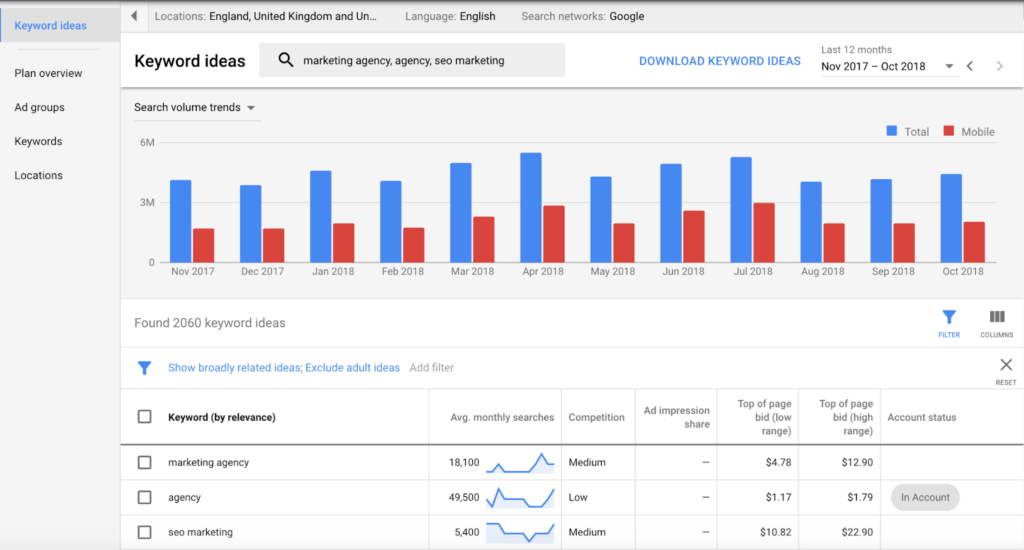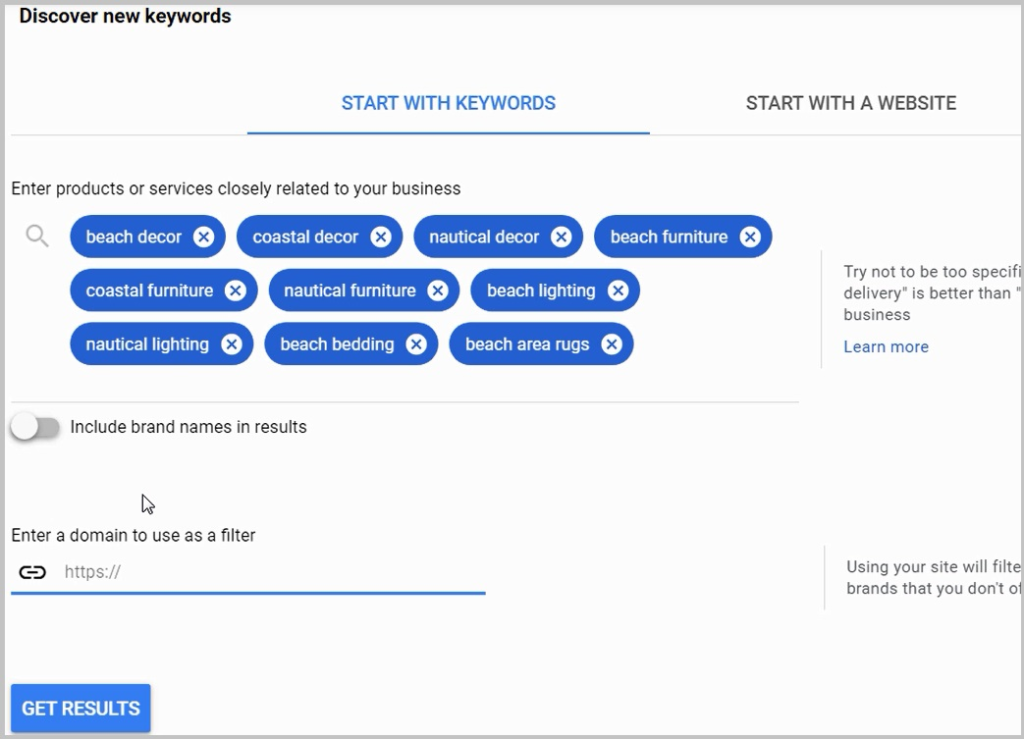
Imagine going through hundreds of shops just to find a pencil. You won’t do that. You’ll probably select the first shop that has a decent pencil. That’s precisely what it’s like on the Internet. You need to be the first one with the solution. Digital visibility is necessary for all businesses; without it, success is limited.

One way to gain visibility is to advertise on the most popular site: Google. However, advertising on this platform takes work. To plan and execute this comprehensive campaign, you must use a Google Keyword Planner tool.
Read on to learn more about the Google Keyword Planner Tool, how to use it, and some expert tips.
What is the Google Keyword Planner Tool?
Marketers use keyword planner tools to find relevant and high-volume keywords. Keyword planner tools provide information about trending keywords, search numbers/volumes, competition, and pricing. Many keyword planner tools are available on the internet; however, the most popular one is the Google Keyword Planner tool.
Google Ads Keyword Planner, also known as AdWords, allows you to find keywords related to your marketing campaign and business. You can use the tool to understand how many times the relevant keyword is searched for on Google. You can use these keywords to create an expert ad copy.
How to Use Google Keyword Planner Tool
1. Create a keyword plan.
The first thing to do to start your marketing campaign is to create a keyword plan. You can upload a keyword list onto the keyword planner tool if you already have a keyword list. Alternatively, you can search for new keywords. The planner will also allow you to edit the list of keywords, filter them or add new keywords to the plan.

2. Understand the keyword broadcast
Once you’ve created a keyword plan, you will see the statistics for each keyword, including average monthly searches, suggested bid prices, shares, organic impression shares, and competition. You can see the forecast of these numbers. You can change the average daily budget, conversion metrics, and ad groups to see which keywords are trending when and under which filter.
3. Organize your keywords
You will have to go through all metrics before you can start organizing keywords. The Google Ads Keyword Planner tool allows you to organize the keywords automatically. Alternatively, you can manually manage the list. The keyword list can be organized based on the average daily bid price, search volume, ad share impressions, competition, and average organic position.
4. Narrow down your list
You can narrow your list by picking essential items. For example, if you have a daily ad bid price in mind, disregard keywords that have higher bidding prices. Alternatively, you can disregard keywords with low search volumes or those not directly related to your brand or products.
5. Customize your date range
Keywords, like seasons, have trends. For example, Halloween-related keywords will trend during September-October, while Christmas-related keywords will trend during November-December. Therefore, customize your date range on the planner to understand how trends affect your keywords’ search volumes. Some keywords have seasonal trends, while others are evergreen.
6. Create content and start bidding
The Google Ads Keyword Planner tool can give you excellent insights into campaign management. Once you have narrowed down the list of keywords, you can create ad copies. You can then bid on the keywords by setting a maximum cost-per-click (CPC). You can set the CPC for individual or groups of keywords and change the bid amount at any time. You have to submit the Google ad at the time of bidding.
7. Run the campaign
Google will evaluate your ad on the grounds of its relevance. It will also evaluate the website or product the ad is promoting and provide the ad with a Quality Score. You will be given an ad rank according to the Quality Score, and your ad will be featured accordingly. You can improve the ad ranking by improving the quality score.

That’s it!
3 Reasons to Use Google’s Keyword Planner Tool
Here are some reasons why Google Ads Keyword Planner should be your go-to tool when starting a new marketing campaign.
1. It can help you find and target the right audience.
Google Ads Keyword Planner stores a lot of historical data. When you search for a relevant keyword, you can learn about the average monthly volume and how the search trend has changed. This allows you to determine which keywords are used by your audience. You can then integrate these keywords into your content.

2. It can help you stay within budget.
Running a Google Ads campaign is an expensive undertaking. Your investment may be wasted if you do not understand the keywords your target audience is looking for. Google Ads Keyword Planner allows you to check the search volume and shows the keyword’s pricing.
This way, you can determine how many competitors are bidding on the same project and whether or not you should do the same.
3. Running and managing the campaign is easy.
Google Ads Keyword Planner is relatively easy to use. You can use the sort, save, and other functions to keep track of your keywords. This way, you can easily manage the campaign from start to end. Furthermore, the impressions, clicks, and other data allow you to determine the success of your campaign.
These are only three advantages of keyword planner tools. You can easily use these to find various types of keywords.
Wrapping Up
Running ads on Google is one of the best ways to gain users’ attention. However, Google Ads is a competitive platform. Utilizing tools like Google keywords planner is a great way to develop a strong marketing strategy. As the article has highlighted, keywords determine the quality score your ad receives.
If you’re unsure how to integrate these keywords into your ad copies, you can reach out to Pepper Content. Pepper Content provides comprehensive content writing services, from ad copies to SEO-friendly blogs and articles.

FAQs
You need a Google Ads account to access the Google Keyword Planner Tool. Signing up for Google Ads is free. However, you need to pay to get the services.
While you can rely on the statistics of Google Keyword Planner, remember that this tool is not for SEO. It is a keyword planner tool for Google Ads. Therefore, while it does provide some estimate of how users search, it does not accurately show keywords for SEO content.
Google Keyword Planner shows high-ranking keywords. If you cannot see your desired keywords, it is probably because they are not as popular. If the search volume is too low, the keyword(s) will not be shown by the keyword planner tool.
Most devices and users use Google to search for necessary information. While other keyword planner tools show high-volume keywords, to some extent, they also consider keywords ranking on other sites. On the other hand, Google Keyword Planner only shows keywords with a high search volume on Google Ads, making it more accurate.
Google Keyword Planner provides various filtering options. You should filter the keyword list based on your budget, audience, and volume.
Latest Blogs
Learn how to rank on AI search engines like ChatGPT, Perplexity, and Gemini by optimizing your content for authority, structure, and relevance. Stay ahead in AI-driven search with this strategic guide.
Explore the best healthcare SEO services for your medical practice. Improve online visibility and effectively reach more patients in need of your services.
Discover top social media agencies specializing in banking solutions, enhancing financial services and driving engagement.
Get your hands on the latest news!
Similar Posts

SEO
5 mins read
Top 10 Agencies for Banking and Financial SEO Services Industry

SEO
4 mins read
Top 10 B2B Enterprise SEO Agency Options for Effective Digital Marketing

Artificial Intelligence
5 mins read